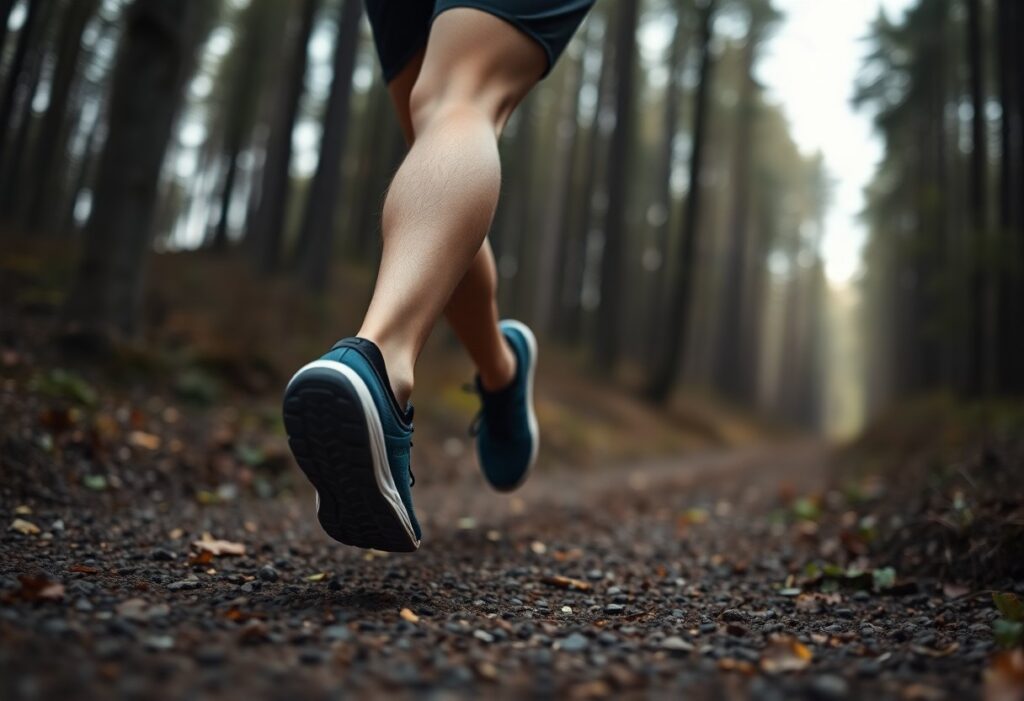
The alarming issue of injury rates among trail runners can escalate to a staggering 62% per year, often due to the selection of inappropriate footwear. Understanding the biomechanics of minimalist footwear and its interaction with the uneven terrain is critical for improving performance while reducing the risks linked with running. By utilising wearable technology, you can effectively monitor essential metrics such as foot strike dynamics and load patterns, while personalised training programmes are crafted to enhance foot strength and stamina. This article explores how you can leverage biomechanical knowledge and innovative technology for effective injury prevention strategies.

Enhancing Your Trail Running Experience with Minimalist Footwear
To successfully navigate the diverse and rugged landscape of trail running while donning minimalist footwear, it is imperative to go beyond merely selecting the right shoes; a profound understanding of your own biomechanics is essential. Neglecting to recognise the specific challenges posed by various surfaces can significantly increase your risk of sustaining injuries. As the mechanics of foot strikes and descent vary, adjusting your technique accordingly is vital for preserving peak performance and minimising potential setbacks that could hinder your running journey.
Deciphering Biomechanical Foot Strike Patterns on Technical Trails
The dynamics of foot strikes can vary remarkably across intricate terrains. Runners opting for minimalist footwear frequently exhibit a striking 23% higher occurrence of midfoot strikes on irregular trails, compared to just 8% seen with traditional running shoes. This shift can enhance your stability on challenging surfaces, but it also leads to a 37% increase in metatarsophalangeal joint flexion angles, indicating the importance of strengthening your foot muscles to bolster endurance and mitigate injury risks effectively.
Analysing the Effects of Descent Mechanics and Ground Interaction
The mechanics involved in descending from elevations significantly influence your performance and injury risk in trail running. The adoption of minimalist footwear can result in a notable 42.191 BW/s increase in vertical loading rates on steep declines of 15%, particularly when contrasted with flat asphalt surfaces. Furthermore, this increase in loading leads to heightened lateral toe engagement — approximately 11% greater on loose gravel compared to structured terrains, underscoring the greater demands placed on your feet's structural integrity during descents.
When navigating technical trails in minimalist shoes, the biomechanics of your feet engage in a distinct manner. The elevated vertical loading rates during descents may lead to increased fatigue within your foot muscles, amplifying your vulnerability to injuries. Additionally, substantial shifts in toe splay patterns necessitate improved proprioception and muscle coordination, ensuring you respond adeptly to the varying terrains beneath your feet. By honing in on these aspects, you can successfully prepare your body to tackle the challenges posed by diverse trails, optimising your overall running performance.
Recognising the Challenges of Wearable Technology in Trail Running
While wearable technology has revolutionised trail running, it also introduces significant challenges in accurately monitoring performance metrics. The variability of terrain conditions, including steep inclines and uneven surfaces, complicates data collection and interpretation. For example, wearable devices often struggle to provide consistent vertical oscillation measurements due to changing ground conditions, which can result in misleading insights regarding your gait and overall running efficiency.
Investigating Data Accuracy Discrepancies Among Leading Performance Devices
Notable discrepancies in data accuracy have emerged among top performance tracking devices. A study conducted in 2024 revealed a 12.4% variance in power measurements on 10% inclines between the Stryd and GARMINRP devices, despite both exhibiting high intra-device reliability (ICC=0.89). Such inconsistencies may lead to misguided perceptions regarding your training load and overall performance, potentially hindering your ability to optimise your trail running capabilities effectively.
and GARMINRP devices, despite both exhibiting high intra-device reliability (ICC=0.89). Such inconsistencies may lead to misguided perceptions regarding your training load and overall performance, potentially hindering your ability to optimise your trail running capabilities effectively.
The Risks Associated with Training Load Miscalculations
Miscalculations in training loads can amplify by as much as 23% on mixed-terrain routes, directly influencing your risk of injury and your performance progression. This error commonly emerges from inaccurate data interpretations during technical descents or uneven terrain, compelling you to rely on potentially flawed metrics. Such discrepancies can result in overtraining or insufficient load management, significantly raising your chances of sustaining injuries while running.
In complex trail environments, the gap between measured and actual exertion can distort your training insights. If your device underreports your exertion, you may inadvertently push beyond your limits, leading to enhanced fatigue and prolonged recovery times. Conversely, if your training load is overestimated, you may adopt a more cautious approach, unintentionally stunting your performance gains. Ultimately, ensuring that your wearable technology informs rather than misleads your training strategy is vital for maintaining both performance and overall health within the dynamic landscape of trail running.
Examining Gender Differences in Trail Running Biomechanics
Gaining a thorough understanding of the biomechanical distinctions between male and female trail runners can significantly enhance performance and reduce injury risks. Research indicates that anatomical and physiological variations affect shoe selection, gait patterns, and susceptibility to injuries. Customising footwear and training programmes based on these gender-specific factors fosters safer and more effective outdoor running experiences for all athletes.
Exploring Gender-Specific Biomechanical Responses Following Exercise
Post-exercise, female runners have demonstrated a 19% increase in lateral forefoot pressures compared to their male counterparts after completing 5km barefoot runs. Additionally, they exhibit a 22% reduction in navicular drop during 50km ultra-marathons, suggesting that their biomechanical adaptations to trail running are unique. Recognising these patterns is crucial for enhancing footwear design that caters to the distinct biomechanics of female runners.
Providing Solutions to Address Gender-Specific Challenges
To effectively tackle the unique biomechanics of female runners, it is essential to implement tailored solutions that consider their specific physical characteristics. Customising training programmes, employing gender-appropriate footwear, and enhancing strength training regimens can significantly decrease injury rates while improving running performance. For example, integrating exercises that focus on intrinsic foot muscle endurance and stability can be particularly beneficial for women, who may experience different loading patterns on technical terrains.
By analysing data from a variety of studies and incorporating findings on gender-specific responses, you can better focus on training and footwear that actively support your unique biomechanics. For instance, utilising targeted strength training regimens that enhance the lower leg and foot can assist your body in adapting to the heightened demands of trail running, especially for women who often experience increased pressure in the forefoot region. Selecting shoes specifically designed for your unique foot mechanics can further aid in addressing common injuries, ultimately fostering a more rewarding and sustainable trail running experience.

Utilising Innovative Techniques for Real-Time Gait Analysis
Your running performance and safety can be significantly enhanced through the application of real-time gait analysis utilising advanced technological methods. By employing integrated systems and wearable devices, you can receive immediate feedback regarding your foot strike patterns, body mechanics, and overall movement efficiency. These sophisticated tools are designed to provide actionable insights while you are actively on the trail, empowering you to dynamically adjust your technique and prevent repetitive strain injuries commonly associated with improper running form.
The Importance of Embedded Sensors in Injury Prevention
Embedded sensors within footwear play a pivotal role in preventing injuries. They continuously monitor your foot strike patterns and pressure distributions in real time, allowing for immediate corrective feedback. This advanced technology enables you to identify deviations from optimal running mechanics before they escalate into serious injuries. With a mere 19-millisecond latency in ground contact alerts, you will receive timely notifications that help you maintain alignment with biomechanical standards that are crucial for injury avoidance.
Long-Term Studies Demonstrating the Effectiveness of Biometric Feedback Technologies
Longitudinal studies illustrate significant improvements in injury rates among trail runners who utilise biometric feedback technologies. Over a period of six months, athletes reported a 37% reduction in aberrant loading patterns due to ongoing monitoring and adjustments informed by real-time data. This robust evidence underlines how sustained engagement with these technologies can enhance your running economy and resilience, thereby decreasing the likelihood of injuries linked to gait abnormalities.
For instance, a comprehensive study involving 250 trail runners documented the effectiveness of wearable sensors in identifying patterns that lead to overuse injuries. Runners who actively engaged with feedback systems reported a 30% lower incident rate of common injuries such as plantar fasciitis and Achilles tendinitis compared to those who relied solely on traditional training methods. The focus on continuous tracking, combined with targeted adjustments based on data insights, highlights a trend towards a more proactive approach to injury prevention in the realm of trail running.
Final Thoughts on Trail Running Biomechanics
In conclusion, a thorough understanding of the biomechanics of trail running in minimalist footwear is essential for optimising your performance while minimising the risk of injury. By seamlessly integrating wearable technology and adopting tailored training methodologies, you can significantly improve both your foot strength and adaptability to various terrains. Regularly cross-validating metrics from different devices and monitoring your gait using advanced tools enables you to personalise your training regimen effectively. This approach not only supports your running journey but also promotes sustainable practices in your outdoor pursuits.
The Article Trail Running Biomechanics in Minimalist Footwear: Integrating Wearable Technology and Injury Prevention Strategies appeared first on My Shoes Finder
The Article Trail Running Biomechanics: Injury Prevention with Minimalist Shoes Was Found On https://limitsofstrategy.com






